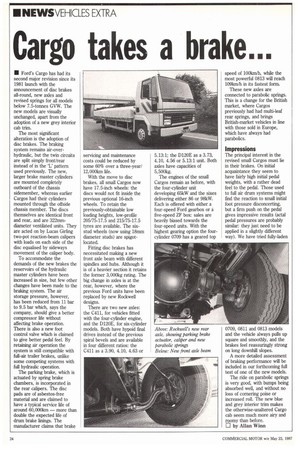Cargo takes a brake...
Page 26

If you've noticed an error in this article please click here to report it so we can fix it.
• Ford's Cargo has had its second major revision since its 1981 launch with the announcement of disc brakes all-round, new axles and revised springs for all models below 7.5-tonnes GVW. The new models are visually unchanged, apart from the adoption of a new grey interior cab trim.
The most significant alteration is the adoption of disc brakes. The braking System remains air-overhydraulic, but the twin circuits are split simply front/rear instead of in the L' pattern used previously. The new, larger brake master cylinders are mounted completely outboard of the chassis sidemember, whereas earlier Cargos had their cylinders mounted through the offside chassis member. The discs themselves are identical front and rear, and are 322mmdiameter ventilated units. They are acted on by Lucas Girling two-pot reaction-beam calipers with loads on each side of the disc equalised by sideways movement of the caliper body.
To accommodate the demands of the new brakes the reservoirs of the hydraulic master cylinders have been increased in size, but few other changes have been made to the braking system. The air storage pressure, however, has been reduced from 11 bar to 9.5 bar which, says the company, should give a better compressor life without affecting brake operation. There is also a new foot control valve which is claimed to give better pedal feel. By retaining air operation the system is still compatible with full-air trailer brakes, unlike some competing systems with full hydraulic operation.
The parking brake, which is actuated by spring brake chambers, is incorporated in the rear calipers. The disc pads are of asbestos-free material and are claimed to have a typical service life of around 60,000km — more than double the expected life of drum brake linings. The manufacturer claims that brake servicing and maintenance costs could be reduced by some 60% over a three-year/ 12,000km life.
With the move to disc brakes, all small Cargos now have 17.5-inch wheels: the discs would not fit inside the previous optional 16-inch wheels. To retain the previously-obtainable low loading heights, low-profile 205/75-17.5 and 215/75-17.5 tyres are available. The sixstud wheels (now using 18mm diameter studs) are spigotlocated.
Fitting disc brakes has necessitated making a new front axle beam with different spindles and hubs. Although it is of a heavier section it retains the former 3,000kg rating. The big change in axles is at the rear, however, where the previous Ford units have been replaced by new Rockwell designs.
There are two new axles: the C411, for vehicles fitted with the four-cylinder engine, and the D120E, for six-cylinder models. Both have hypoid final drives instead of the previous spiral bevels and are available in four different ratios: the C411 as a 3.90, 4.10, 4.63 or 5.13:1; the D120E as a 3.73, 4.10, 4.56 or 5.13:1 unit. Both axles have capacities of 5,500kg.
The engines of the small Cargos remain as before, with the four-cylinder unit developing 65kW and the sixes delivering either 86 or 98kW. Each is offered with either a four-speed Ford gearbox or a five-speed ZF box: sales are heavily biased towards the four-speed units. With the highest gearing option the fourcylinder 0709 has a geared top speed of 1001tm/h, while the most powerful 0813 will reach 109km/h in its fastest form.
These new axles are connected to parabolic springs. This is a change for the British market, where Cargos previously had had multi-leaf rear springs, and brings British-market vehicles in line with those sold in Europe, which have always had parabolics.
WPM/lions The principal interest in the revised small Cargos must lie in their brakes. On initial acquaintance they seem to have fairly high initial pedal weights, with a rather dead feel to the pedal. Those used to full air drum systems might find the reaction to small initial foot pressure disconcerting, but a firm push on the pedal gives impressive results Octal pedal pressures are probably similar: they just need to be applied in a slightly different way). We have tried fully-laden 0709, 0811 and 0813 models and the vehicle always pulls up square and smoothly, and the brakes feel reassuringly strong on long downhill slopes.
A more detailed assessment of braking performance will be included in our forthcoming full test of one of the new models.
The ride on parabolic springs is very good, with bumps being absorbed well, and without no loss of cornering poise or increased roll. The new blue and grey interior trim makes the otherwise-unaltered Cargo cab seem much more airy and roomy than before. LI by Allan Winn




























































































